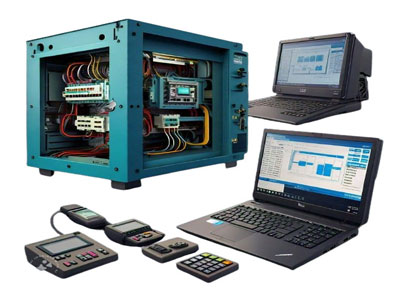Key Takeaway
SCADA plays a vital role in smart grid technology by enabling real-time monitoring, control, and automation of power distribution systems. It collects data from sensors, substations, and other devices across the grid, helping operators track energy flow, detect faults, and optimize performance. This ensures reliable and efficient power delivery to consumers.
In smart grids, SCADA also supports demand-response management by balancing energy supply and demand dynamically. It integrates with renewable energy sources like solar and wind, ensuring their seamless addition to the grid. Additionally, SCADA enhances grid reliability by providing early fault detection and enabling rapid response to outages. By facilitating data-driven decisions and automation, SCADA contributes to the efficiency, flexibility, and sustainability of smart grid systems.
SCADA's Role in Real-Time Monitoring of Smart Grids
Real-time monitoring is critical in smart grid systems, where rapid decision-making ensures uninterrupted power supply. SCADA acts as the eyes and ears of the grid, providing operators with up-to-the-second data on voltage levels, current flow, and equipment health.
For example, when a power line experiences a fault, SCADA systems immediately detect the anomaly and alert operators. This swift notification allows for quick interventions, reducing downtime and minimizing disruptions to consumers. SCADA also enables operators to monitor energy demand across different regions, ensuring that power distribution aligns with real-time requirements.
By consolidating data from substations, transformers, and other grid components, SCADA provides a centralized overview of the entire network. This comprehensive visibility empowers operators to make informed decisions and maintain system stability, even during peak loads or emergencies.

Enhancing Grid Efficiency and Reliability Through SCADA
Efficiency and reliability are the hallmarks of a smart grid, and SCADA plays a pivotal role in achieving these goals. Through automation, SCADA optimizes energy flow, reduces wastage, and ensures consistent power delivery.
One way SCADA enhances efficiency is through automated load balancing. By analyzing real-time data, SCADA adjusts power generation and distribution to match consumption patterns. For instance, during high-demand periods, it prioritizes power allocation to critical areas while preventing grid overloading.
Reliability is further bolstered by SCADA’s ability to perform fault isolation and system restoration. When an issue arises, such as a transformer failure, SCADA quickly isolates the affected section, preventing the fault from cascading through the network. Meanwhile, power is rerouted to maintain supply in unaffected areas.
This proactive approach minimizes downtime, protects equipment from damage, and ensures a stable energy supply for consumers.
Integration of Renewable Energy Sources in Smart Grids Using SCADA
The transition to renewable energy is a cornerstone of modern smart grids, and SCADA is integral to this shift. Renewables like solar and wind are inherently variable, making their integration into the grid challenging. SCADA addresses these challenges by monitoring and managing renewable energy sources in real time.
For instance, SCADA tracks solar panel output based on sunlight intensity and adjusts grid operations accordingly. Similarly, in wind farms, it monitors wind speed and turbine performance to optimize energy generation. This ensures that renewable sources are utilized to their full potential while maintaining grid stability.
Additionally, SCADA facilitates the coordination between renewable energy systems and energy storage solutions, such as batteries. Excess energy generated during peak production is stored for later use, ensuring a consistent power supply even when renewable output fluctuates.
By seamlessly integrating renewables, SCADA supports the transition to cleaner energy while ensuring the grid remains efficient and reliable.
SCADA's Contribution to Predictive Maintenance and Fault Detection
Predictive maintenance is a game-changer in smart grid operations, and SCADA is at the forefront of this innovation. Through continuous monitoring, SCADA identifies early signs of wear and tear in grid components, such as transformers, cables, and circuit breakers.
For example, SCADA systems track parameters like temperature, vibration, and load fluctuations. If a transformer begins to overheat, SCADA immediately alerts operators, enabling them to address the issue before it escalates into a failure.
Fault detection is equally critical. SCADA not only identifies faults but also pinpoints their exact location, saving valuable time during repairs. In a smart grid, where downtime can disrupt entire communities, this capability is indispensable.
By enabling predictive maintenance and rapid fault resolution, SCADA reduces operational costs, extends equipment lifespan, and ensures uninterrupted energy delivery.
Data Analytics and Decision-Making in Smart Grids with SCADA
Data is the driving force behind smart grids, and SCADA transforms raw data into actionable insights. Every component of the grid, from substations to meters, generates vast amounts of data. SCADA collects, processes, and analyzes this information to support informed decision-making.
For example, historical data trends analyzed by SCADA can reveal inefficiencies in energy distribution, allowing operators to optimize grid operations. Predictive analytics powered by SCADA helps forecast energy demand, enabling better resource planning and reducing the risk of outages.
Moreover, SCADA’s automated reporting capabilities simplify compliance with regulatory requirements. Reports on energy usage, emissions, and system performance can be generated with minimal effort, saving time and ensuring accuracy.
With its robust data analytics capabilities, SCADA empowers smart grids to operate more intelligently, adapting to changing energy demands and supporting long-term sustainability goals.
Conclusion
SCADA systems are the cornerstone of smart grid technology, ensuring real-time monitoring, efficient energy distribution, and seamless integration of renewable sources. They also enable predictive maintenance and data-driven decision-making, making smart grids more reliable and adaptive to modern energy challenges.
For engineers entering this exciting field, understanding SCADA’s role in smart grids is crucial. By leveraging SCADA’s full potential, we can create energy systems that are not only efficient and reliable but also sustainable for the future.
